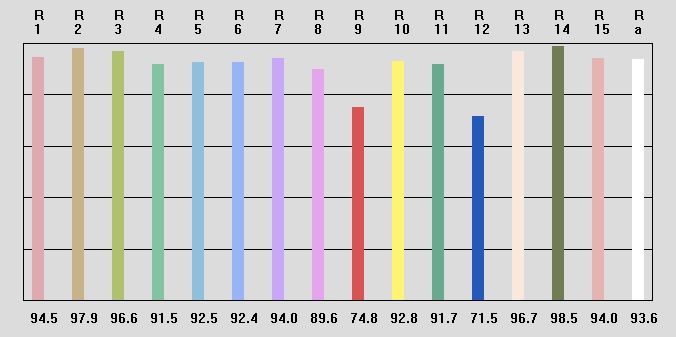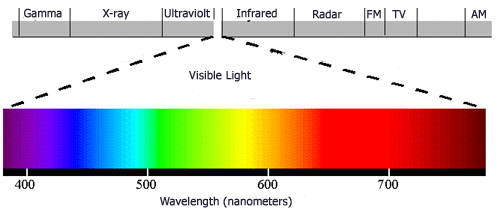What is CRI and Why is it so Important?
Have you ever left your house wearing a new jacket or sweater only to glance in a mirror at your destination and realize that it looks totally different? This can be very confusing. I think that most of us would put it down to the light being different in the two locations. Knowing this how do you work out what light is showing the right color? This is why it is important to understand the Color Rendering Index (CRI) of light sources.

Becky Worley @bworley does a great job of highlighting the frustrations that many people have with lights in the dressing room at different shops in a video she did for ABC https://abcnews.go.com/Lifestyle/store-dressing-room-design-affect/story?id=32841724. In the video, she correctly points out that light really does make a difference. A lot of times people will take for granted how important lighting can be in making simple decisions such as buying a sweater.
There are many factors to consider when lighting up any space such as brightness, color temperature location, etc. It would be a big mistake to overlook the CRI of your light source with regard to the overall function and effect you wish to convey.
What is CRI
The purpose of this article is NOT to overwhelm but to inform in the simplest way possible the importance of CRI. Let look at what the Color Rendering Index is. The name gives it away, it is the way in which the color is rendered in relation to the light source. Render is a synonym of make — technically it means “cause to become.” In relation to lights render would apply to how an object would appear to the eye because of the light source. CRI is, therefore, the measurement that tells you how accurately the light source reflects the object to your eye.
So how is CRI measured? The yardstick by which CRI is measured has to be broken into a number of parts. First, we will look to below a color temp of 5000k. Up to this, we measure CRI against an incandescent light or a halogen bulb. How an object appears under an incandescent/halogen light source gets a CRI of 100. How the same object appears under a different light source (LED, Florocesent, CFL etc) will determine its CRI score. Above 5000k the CRI is determined as to how an object appears against direct sunlight, this has many different variables due to conditions and time of day.
The CRI index is, therefore, a comparison tool that compares the light spectrum of any light source to the light spectrum of any watt incandescent/halogen light below 5000k. If an object is the same under any other light source mentioned above it will have a CRI index score of 100.
How is CRI measured?
Now that we know what is measured by, we can look to how it is measured. We use a series of pastels to give us a CRI score. Traditional CRI measurement goes from R1 to R8 but as you can see it leaves out the vivid colors on the spectrum, most notably Red and Blue. The extended measurement includes red, yellow, blue and green.

It is important to understand this espicially in relation to LED technology. Most LEDs are made up of a blue emitter that is treated with yellow prosper. If you are to take a look at the color spectrum  Violet/Blue are at one ond while Red is at the opposite end. What this means is normal LEDs won’t show this very well.
Violet/Blue are at one ond while Red is at the opposite end. What this means is normal LEDs won’t show this very well.
Trade-Off
At Smart LED Concepts we always take a customer-first approach when it comes to LED technology. We emphasize that knowing your why or your end goal is the most important factor when determining your light design. There is a trade-off with CRI and brightness in most cases when it comes to LED lights. A CRI of 95, for example, can have a decreased brightness of up to 20% as a similar LED light with a CRI of 80. Most manufacturers will go for brightness above CRI as the market is favoring brightness above aesthetics in most instances. Every project is different and understanding the differences and needs will help you to create the long term results that you seek.
There are different indexes that you can look to determine the right light for your situation. CQS – Color Quality Score this is a newer metric that you will see more often as the industry evolves. It bridges the gap between the shortcomings of the traditional CRI model.
Applications in Understanding CRI
Restaurants make up a lot of our clients. I always state the importance of understanding what lights go where. Sometimes I will speak with a restaurant owner who gets excited to put RGB LED lights everywhere. This, however, is not a good idea. For example, if they are showcasing food, imagine a rare steak under the wrong light, it can seriously impact the look of the steak and the customer’s enjoyment. Never underestimate what the visual impact can have on the overall enjoyment of the customer experience.
Imagine if you will, a designer who put an extreme amount of effort into getting the materials to create a particular look. If they are using a strong wood look – with hints of red throughout the material. The right light with the wrong CRI will undo all the great work that has gone into the design, you will end up with a flat unimpressive space.
No matter what your project please take the time to discuss the implications that CRI will have. Speak to an expert, big-picture focus and an understanding of the desired outcome is critical to achieving your goals.

- Cut energy consumption up to 80%
- Provide a brighter / higher quality light
- Cut down maintenance Costs
- Expected ROI between (1.5 – 3 years)
- 5 Year Warranty
Want to attract more business?
Smart LED Concepts will work with your contractors and designers to create and illuminate custom lighting that will make your business shine.
Because Smart LED Concepts used LED fixtures in the venue, the running and maintenance cost is 70% less than venues that use traditional lighting methods.
Categories: Blog, Business, Commercial LED, Commercial Lighting, Electric, going green, Restaurant LightingDecember 18, 2018Share this post
Related posts
A Guide to Great Landscaping Lighting
September 30, 2019LED Lighting Design Tips.
September 27, 2019Exterior LED Lights for Hotels
September 27, 2019Let’s talk about Flex…
September 24, 2019LED vs CFL
September 23, 2019Value Engineering & LED Lights
September 20, 2019NEWS & EVENTS
- A Guide to Great Landscaping Lighting
September 30, 2019 - LED Lighting Design Tips.
September 27, 2019 - Exterior LED Lights for Hotels
September 27, 2019 - Let’s talk about Flex…
September 24, 2019
Categories: Blog, Business, Commercial LED, Commercial Lighting, Electric, LED Commercial lighting, LED Concepts, LED Design Products, LED DESIGNS, LED DISPLAYS, LED Lighting, Lighting, NEWS, Portfolio, Products, Residential, Restaurant Lighting, UncategorizedOctober 11, 2019Share this post






